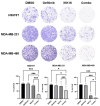Inhibition of IκB Kinase Is a Potential Therapeutic Strategy to Circumvent Resistance to Epidermal Growth Factor Receptor Inhibition in Triple-Negative Breast Cancer Cells
- PMID: 36358633
- PMCID: PMC9654813
- DOI: 10.3390/cancers14215215
Inhibition of IκB Kinase Is a Potential Therapeutic Strategy to Circumvent Resistance to Epidermal Growth Factor Receptor Inhibition in Triple-Negative Breast Cancer Cells
Abstract
Triple-negative breast cancer (TNBC) remains as an intractable malignancy with limited therapeutic targets. High expression of epidermal growth factor receptor (EGFR) has been associated with a poor prognosis of TNBC; however, EGFR targeting has failed with unfavorable clinical outcomes. Here, we performed a combinatorial screening of fifty-five protein kinase inhibitors with the EGFR inhibitor gefitinib in the TNBC cell line MDA-MB-231 and identified the IκB kinase (IKK) inhibitor IKK16 as a sensitizer of gefitinib. Cell viability and clonogenic survival assays were performed to evaluate the antiproliferative effects of the gefitinib and IKK16 (Gefitinib + IKK16) combination in TNBC cell lines. Western blot analyses were also performed to reveal the potential mode of action of this combination. In addition, next-generation sequencing (NGS) analysis was performed in Gefitinib+IKK16-treated cells. The Gefitinib+IKK16 treatment synergistically reduced cell viability and colony formation of TNBC cell lines such as HS578T, MDA-MB-231, and MDA-MB-468. This combination downregulated p-STAT3, p-AKT, p-mTOR, p-GSK3β, and p-RPS6. In addition, p-NF-κB and the total NF-κB were also regulated by this combination. Furthermore, NGS analysis revealed that NF-κB/RELA targets including CCL2, CXCL8, EDN1, IL-1β, IL-6, and SERPINE1 were further reduced and several potential tumor suppressors, such as FABP3, FADS2, FDFT1, SEMA6A, and PCK2, were synergistically induced by the Gefitinib-+IKK16 treatment. Taken together, we identified the IKK/NF-κB pathway as a potential target in combination of EGFR inhibition for treating TNBC.
Keywords: IκB kinase (IKK) inhibition; anticancer; combination; epidermal growth factor receptor (EGFR) inhibition; gefitinib; kinase inhibitor; resistance; synergism; triple-negative breast cancer (TNBC).
Conflict of interest statement
The authors declare no conflict of interest.
Figures






Similar articles
-
Inhibition of RPTOR overcomes resistance to EGFR inhibition in triple-negative breast cancer cells.Int J Oncol. 2018 Mar;52(3):828-840. doi: 10.3892/ijo.2018.4244. Epub 2018 Jan 15. Int J Oncol. 2018. PMID: 29344641
-
Dual Inhibition of AKT and MEK Pathways Potentiates the Anti-Cancer Effect of Gefitinib in Triple-Negative Breast Cancer Cells.Cancers (Basel). 2021 Mar 10;13(6):1205. doi: 10.3390/cancers13061205. Cancers (Basel). 2021. PMID: 33801977 Free PMC article.
-
Dual inhibition of EGFR and MET induces synthetic lethality in triple-negative breast cancer cells through downregulation of ribosomal protein S6.Int J Oncol. 2015 Jul;47(1):122-32. doi: 10.3892/ijo.2015.2982. Epub 2015 May 4. Int J Oncol. 2015. PMID: 25955731 Free PMC article.
-
Potentiating Therapeutic Effects of Epidermal Growth Factor Receptor Inhibition in Triple-Negative Breast Cancer.Pharmaceuticals (Basel). 2021 Jun 18;14(6):589. doi: 10.3390/ph14060589. Pharmaceuticals (Basel). 2021. PMID: 34207383 Free PMC article. Review.
-
Myricetin-induced apoptosis in triple-negative breast cancer cells through inhibition of the PI3K/Akt/mTOR pathway.Med Oncol. 2022 Oct 8;39(12):248. doi: 10.1007/s12032-022-01856-z. Med Oncol. 2022. PMID: 36209343 Review.
Cited by
-
Divergent Processing of Cell Stress Signals as the Basis of Cancer Progression: Licensing NFκB on Chromatin.Int J Mol Sci. 2024 Aug 7;25(16):8621. doi: 10.3390/ijms25168621. Int J Mol Sci. 2024. PMID: 39201306 Free PMC article. Review.
-
Targeting the EGFR signaling pathway in cancer therapy: What's new in 2023?Expert Opin Ther Targets. 2023 Apr-May;27(4-5):305-324. doi: 10.1080/14728222.2023.2218613. Epub 2023 Jun 2. Expert Opin Ther Targets. 2023. PMID: 37243489 Free PMC article. Review.
-
The molecular mechanism of NF-κB dysregulation across different subtypes of renal cell carcinoma.J Adv Res. 2025 Jun;72:501-514. doi: 10.1016/j.jare.2024.07.030. Epub 2024 Jul 31. J Adv Res. 2025. PMID: 39094893 Free PMC article. Review.
-
Targeting Resistance Pathways in Breast Cancer Through Precision Oncology: Nanotechnology and Immune Modulation Approaches.Biomedicines. 2025 Jul 10;13(7):1691. doi: 10.3390/biomedicines13071691. Biomedicines. 2025. PMID: 40722763 Free PMC article. Review.
-
JAK2 Inhibition Augments the Anti-Proliferation Effects by AKT and MEK Inhibition in Triple-Negative Breast Cancer Cells.Int J Mol Sci. 2025 Jun 26;26(13):6139. doi: 10.3390/ijms26136139. Int J Mol Sci. 2025. PMID: 40649917 Free PMC article.
References
Grants and funding
- NRF-2022R1l1A1A01064022/National Research Foundation of Korea
- NRF-2019R1l1A3A01059102/National Research Foundation of Korea
- NRF-2021R1A5A2022318/National Research Foundation of Korea
- NRF-2021R1I1A2054560/National Research Foundation of Korea
- NRF-2021R1A6A3A01086886/National Research Foundation of Korea
LinkOut - more resources
Full Text Sources
Research Materials
Miscellaneous

